Global B2B Packaged Spices Market Forecast
- The market for B2B packaged spices reached US$596.8 Mn in 2023 and will likely reach US$868.2 Mn by 2030.
- Global B2B packaged spices market size is poised for a CAGR of 5.5% during 2023-2030.
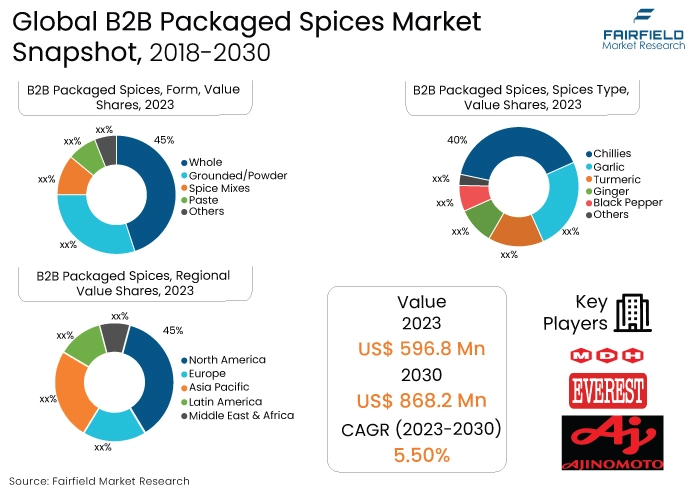
Quick Report Digest
- The key trend driving the B2B packaged spices market is the increasing demand for ethnic and authentic flavours. As consumers continue to explore global cuisines, there is a growing need for diverse and high-quality spice blends that can enhance the authenticity and flavour profile of various dishes across different culinary traditions.
- Demand from the food service industry is expected to drive the B2B packaged spices market as restaurants, hotels, and catering services seek convenient and high-quality spice solutions to enhance the flavour of their dishes. The food service sector's reliance on packaged spices for consistency and efficiency fuels market growth.
- The globalisation of culinary preferences is expected to drive the B2B packaged spices market as consumers increasingly seek diverse and authentic flavours from around the world. This trend creates opportunities for suppliers to offer a wide range of spice blends tailored to different cultural cuisines, driving market expansion.
- The expansion of food manufacturing is expected to drive the B2B packaged spices market as manufacturers require a wide variety of spice blends and seasonings for their products. As food manufacturing grows to meet increasing consumer demand, the need for convenient, high-quality spice solutions will continue to rise, stimulating market growth.
- Chillis spices type has captured the largest market share in the B2B packaged spices market due to its versatility, widespread culinary use, and popularity across various cuisines globally. Known for imparting distinct flavour and heat, chillis are essential ingredients in numerous recipes, making them a staple in spice blends and seasoning formulations.
- Whole form spices have captured the largest market share in the B2B packaged spices market due to their superior flavour retention, longer shelf life, and versatility in culinary applications. They offer convenience in grinding or crushing as needed, catering to the preferences of chefs, food manufacturers, and consumers seeking premium-quality and authentic flavour experiences.
- The Asia Pacific region is growing in the B2B packaged spices market due to its rich culinary heritage, diverse cuisines, and increasing urbanisation. As consumer preferences evolve and demand for convenient and high-quality spice solutions rises, suppliers in the region are well-positioned to cater to this growing market demand.
- The North America region is growing in the B2B packaged spices market due to the increasing demand for diverse and high-quality spice blends driven by the region's multicultural culinary landscape. Additionally, the rise of the foodservice industry and changing consumer preferences for ethnic and international cuisines contribute to market growth.
A Look Back and Look Forward - Comparative Analysis
The B2B packaged spices market is growing due to several factors. Firstly, the rising demand for convenience and ready-to-use ingredients in the foodservice industry drives the adoption of packaged spices by restaurants, catering services, and food manufacturers. Additionally, the increasing preference for standardised quality, shelf-stable products, and bulk purchasing options among businesses further fuels market growth, creating opportunities for suppliers and manufacturers in the B2B spices segment.
The growth of the B2B packaged spices market is primarily driven by the foodservice industry's demand for convenient and high-quality flavouring ingredients. Applications such as restaurants, catering services, hotels, and food manufacturers rely on packaged spices for flavour enhancement, consistency, and efficiency in food preparation. Additionally, the growing popularity of packaged spices in institutional settings such as schools, hospitals, and cafeterias further drives market expansion in the B2B sector.
The future of the B2B packaged spices market appears promising, with continued growth anticipated driven by factors such as the expansion of the foodservice industry, increasing demand for convenience and standardised quality, and the globalisation of culinary preferences. Additionally, advancements in packaging technology, flavour innovations, and sustainable sourcing practices are expected to further drive market growth, creating opportunities for suppliers and manufacturers in the B2B spices segment.
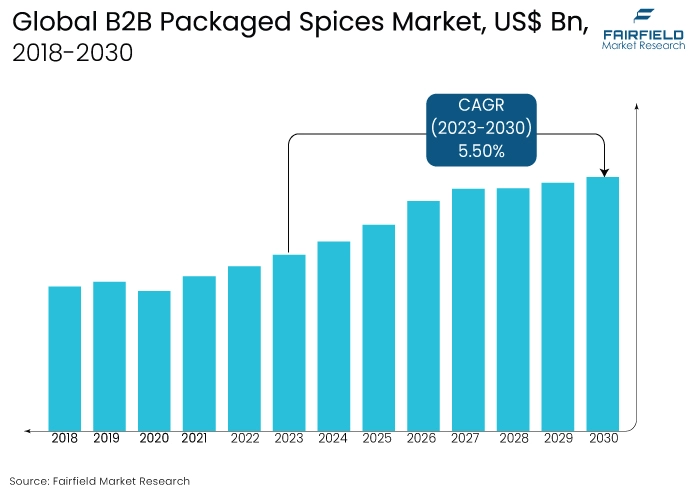
Key Growth Determinants
- Growing Demand from Foodservice Industry
The demand from the foodservice industry is expected to drive the B2B packaged spices market significantly. Foodservice establishments such as restaurants, hotels, catering services, and institutional kitchens require a consistent supply of high-quality spices to enhance the flavour profiles of their dishes.
Packaged spices offer convenience, standardised quality, and ease of use, catering to the busy operational requirements of these businesses. Additionally, as the foodservice sector continues to expand globally due to factors such as urbanisation, changing consumer lifestyles, and increasing dining-out trends, the demand for packaged spices is expected to rise accordingly.
Suppliers and manufacturers catering to the foodservice industry have opportunities to capitalise on this growing demand by offering a wide range of packaged spices tailored to the needs of different cuisines and culinary preferences.
- Globalisation of Culinary Preferences
The globalisation of culinary preferences is anticipated to drive the B2B packaged spices market by expanding the variety of spices demanded by consumers worldwide. As people increasingly explore and embrace diverse cuisines from different cultures, there is a growing demand for a wide range of spices and flavourings to replicate authentic flavours in cooking. This trend creates opportunities for suppliers and manufacturers of packaged spices to cater to the evolving tastes and preferences of global consumers.
Additionally, the availability of packaged spices allows foodservice establishments and manufacturers to experiment with new recipes and ingredients more easily, facilitating the incorporation of international flavours into their offerings. As a result, the globalisation of culinary preferences contributes to the growth and diversification of the B2B packaged spices market on a global scale.
- Expansion of Food Manufacturing Sector
The expansion of food manufacturing activities is poised to drive the B2B packaged spices market significantly. As the food manufacturing sector grows to meet the increasing demand for processed and packaged food products, there is a parallel need for high-quality spices and flavourings to enhance the taste and appeal of these products.
Packaged spices offer convenience, consistency, and standardised quality, making them essential ingredients in various food manufacturing processes. Additionally, as consumers seek more flavourful and diverse food options, manufacturers are exploring new recipes and flavour profiles, leading to greater demand for a wide range of spices.
Suppliers, and manufacturers of packaged spices have opportunities to capitalise on this trend by providing a diverse portfolio of spices tailored to the needs of food manufacturers, contributing to the growth of the B2B packaged spices market.
Major Growth Barriers
- Growing Quality Control Challenges
Quality control challenges pose a significant challenge in the B2B packaged spices market. Ensuring consistent quality standards across batches of spices sourced from diverse regions with varying production practices is complex.
Inconsistencies in flavour, aroma, and potency can impact customer satisfaction and brand reputation. Additionally, stringent food safety regulations necessitate rigorous quality control measures, increasing production costs and operational complexities for suppliers and manufacturers of packaged spices.
- Competition from Fresh Spices
Competition from fresh spices presents a challenge to the B2B packaged spices market. Some consumers prefer the superior aroma and flavour of freshly ground spices over packaged alternatives. This preference can lead to a decline in demand for packaged spices, particularly among culinary professionals seeking premium quality and authenticity.
To address this challenge, packaged spice manufacturers must emphasize the convenience, consistency, and shelf stability of their products to attract and retain customers in the competitive market landscape.
Key Trends and Opportunities to Look at
- Demand for Ethnic and Authentic Flavours
The demand for ethnic and authentic flavours in the B2B packaged spices market is rising as consumers increasingly seek to explore global cuisines. Suppliers have opportunities to meet this demand by offering a diverse range of spice blends tailored to different culinary traditions and flavour preferences.
- Sustainability and Ethical Sourcing
Sustainability and ethical sourcing are gaining importance in the B2B packaged spices market. Suppliers are embracing transparent sourcing practices, obtaining fair trade certifications, and adopting eco-friendly packaging solutions to meet consumer demand for responsibly sourced spices while minimising environmental impact throughout the supply chain.
- Premiumisation and Specialty Blends
Premiumisation and specialty blends are emerging trends in the B2B packaged spices market. Suppliers are capitalising on consumer willingness to pay for high-quality and unique flavour experiences by offering premium spice blends crafted with carefully selected ingredients and innovative flavour profiles, catering to discerning chefs and foodservice establishments.
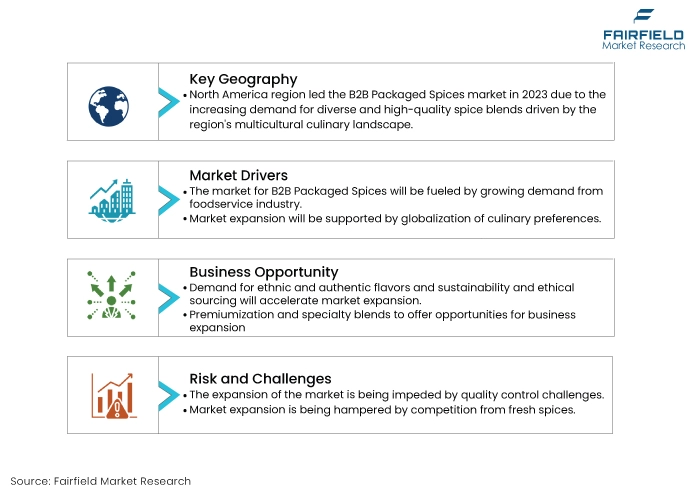
How Does the Regulatory Scenario Shape this Industry?
The B2B packaged spices market is subject to various regulatory frameworks and standards to ensure food safety, quality, and labeling compliance. In the United States, the Food and Drug Administration (FDA) oversees spice safety under the Food Safety Modernisation Act (FSMA) and sets standards for spice labeling, packaging, and storage.
In the European Union, the European Food Safety Authority (EFSA) regulates spices under the General Food Law and sets maximum residue limits for contaminants. Additionally, regional regulations may impact the import and export of spices, such as the Codex Alimentarius Commission's standards for international trade.
Compliance with these regulations influences market entry, product formulation, labeling practices, and supply chain management, ensuring consumer trust and market access while addressing evolving food safety concerns and changing regulatory landscapes
Fairfield’s Ranking Board
Top Segments
- Chillis Maintain Dominance Globally
Chillis have captured the largest market share in the B2B packaged spices market due to its versatile usage, widespread culinary applications, and popularity across various cuisines worldwide. Known for imparting distinct flavour, heat, and vibrant colour to dishes, chillis are indispensable ingredients in numerous recipes, making them a staple in spice blends and seasoning formulations preferred by chefs, food manufacturers, and culinary professionals globally.
Garlic spices are experiencing rapid uptake due to their widespread use, and versatile flavour profile. Recognised for its aromatic and pungent taste, garlic adds depth and complexity to a wide range of dishes across various cuisines. Additionally, growing consumer awareness of garlic's health benefits, such as its antioxidant and antimicrobial properties, further fuels its demand in spice blends and food preparations.
- Whole Spices Sell Higher
The whole form of spices has captured the largest market share in the B2B packaged spices market due to several factors. Whole spices offer superior flavour retention, longer shelf life, and greater versatility in culinary applications compared to ground or powdered forms.
Additionally, they allow for customisation and flexibility in grinding or crushing as needed, catering to the preferences of chefs, food manufacturers, and consumers seeking premium-quality and authentic flavour experiences in their dishes.
The grounded/powder form of spices are also garnering popularity on the back of their convenience, and ease of use. Ground spices offer ready-to-use solutions, saving time and labour for foodservice establishments and manufacturers.
Additionally, ground spices ensure consistent flavour distribution and are suitable for a wide range of culinary applications, making them increasingly popular among chefs and consumers seeking convenience without compromising on taste.
Regional Frontrunners
North America Takes up the Largest Piece of Market Pie
North America has captured the largest market share in the B2B packaged spices market due to several factors. The region boasts a diverse culinary landscape with a high demand for spices across various cuisines, including Mexican, Italian, and Asian cuisines. The presence of a robust foodservice industry, including restaurants, hotels, and catering services, drives significant demand for packaged spices.
Additionally, the region's growing population, changing consumer preferences, and increasing awareness of ethnic and international cuisines contribute to sustained market growth, positioning North America as a key market for suppliers and manufacturers in the B2B packaged spices segment.
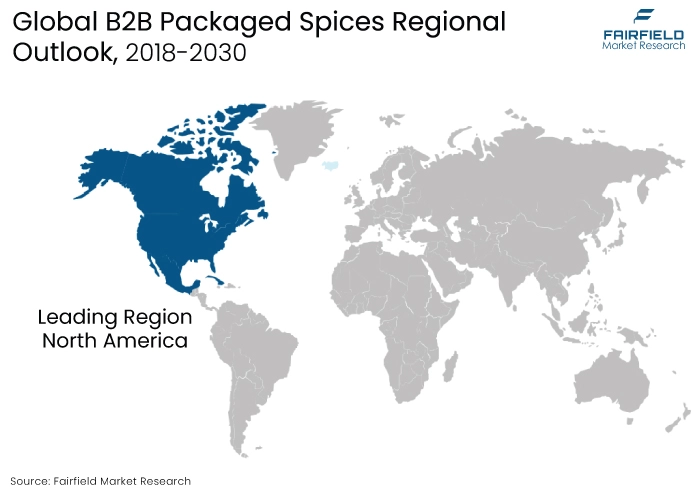
Asia Pacific Likely to Witness the Significant Growth in Sales During Forecast Period
The Asia Pacific region is all set for the highest CAGR for the region's rich culinary heritage, and diverse cuisines that drive robust demand for a wide variety of spices.
The growing population, rising disposable incomes, and urbanisation contribute to increased consumption of packaged spices in food preparation. Additionally, the expanding foodservice industry and growing adoption of international cuisines further stimulate market growth in the region.
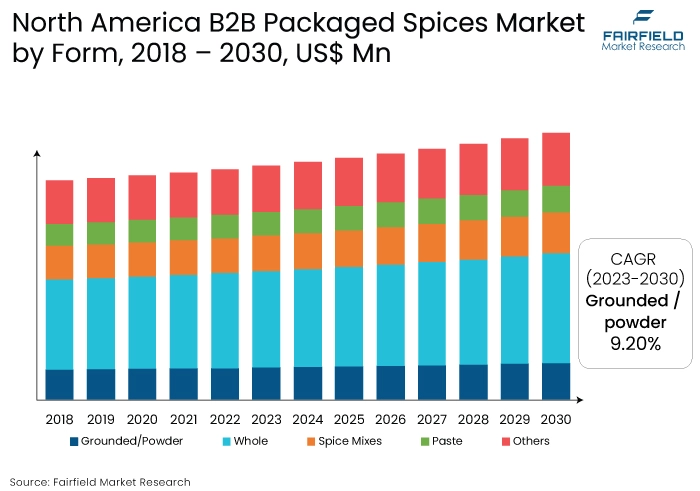
Fairfield’s Competitive Landscape Analysis
The competitive landscape of the B2B packaged spices market is characterised by the presence of numerous suppliers and manufacturers competing on factors such as product quality, pricing, packaging innovation, and distribution networks.
Key players often differentiate themselves through unique spice blends, organic and sustainable offerings, and value-added services. Market leaders leverage their brand reputation and extensive global presence to maintain market share, while smaller players focus on niche markets and specialised spice varieties to compete effectively.
Who are the Leaders in Global B2B Packaged Spices Space?
- MDH Spices
- Everest Spices
- Ajinomoto Co., Inc.
- Badia Spices, Inc.
- Baria Pepper
- Olde Thompson
- Catch Foods
- Pereg Natural Foods
- Olam International Limited
- Dabur India Ltd.
- Everland Natural Foods
- The Hain Celestial Group, Inc.
- Kerry Group
- Cargill, Incorporated
- Unilever
Significant Company Developments
New Product Launch
- January 2022: Kerry inaugurated a cutting-edge facility spanning 21,500 square feet at its Jeddah site in Saudi Arabia.
- March 2021: Sensient Natural Ingredients LLC (SNI) declared the purchase of New Mexico Chili Products Inc., a facility situated in Deming, specialising in dehydrated chili production. This plant processes capsicums and a range of specialty chilies, catering to commercial clients like CPG food manufacturers, spice blenders, and foodservice providers.
An Expert’s Eye
Demand and Future Growth
The B2B packaged spices market is experiencing robust demand and poised for significant future growth. As global culinary preferences diversify and consumer awareness of ethnic cuisines expands, there is an increasing need for high-quality, convenient, and authentic spice solutions among foodservice establishments and manufacturers.
Additionally, the growing trend towards premiumisation, sustainability, and health-consciousness further drives market growth. With the rise of the foodservice industry, urbanisation, and changing consumer lifestyles, the B2B packaged spices market is expected to witness sustained expansion, presenting lucrative opportunities for suppliers and manufacturers to innovate and meet evolving customer demands.
Supply Side of the Market
The demand-supply dynamics in the B2B packaged spices market are influenced by several factors. Increasing demand for convenient and high-quality spice solutions from foodservice establishments and manufacturers drives suppliers to maintain adequate supply levels while ensuring consistent quality standards. Pricing structures are influenced by factors such as production costs, market competition, and consumer preferences for premium or specialty blends.
Pricing strategies will likely continue to impact long-term growth, with suppliers focusing on offering competitive pricing while maintaining profit margins. Major trends driving competition include the rise of premiumisation, sustainability initiatives, and health-consciousness among consumers.
Additionally, technological advancements in packaging and distribution contribute to supply chain efficiency. Suppliers are also investing in transparent sourcing practices and ethical supply chains to meet consumer demand for responsibly sourced spices. Overall, effective supply chain management and strategic pricing strategies will be crucial for sustaining growth in the competitive B2B packaged spices market.
Global B2B Packaged Spices Market is Segmented as Below:
By Spices Type:
- Chillis
- Garlic
- Turmeric
- Ginger
- Black Pepper
- Others
By Form:
- Whole
- Grounded/Powder
- Spice Mixes
- Paste
- Others
By Geographic Coverage:
- North America
- U.S.
- Canada
- Europe
- Germany
- U.K.
- France
- Italy
- Turkey
- Russia
- Rest of Europe
- Asia Pacific
- China
- Japan
- South Korea
- India
- Southeast Asia
- Rest of Asia Pacific
- Latin America
- Brazil
- Mexico
- Argentina
- Rest of Latin America
- Middle East & Africa
- GCC
- South Africa
- Egypt
- Nigeria
- Rest of Middle East & Africa
1. Executive Summary
1.1. Global B2B Packaged Spices Market Snapshot
1.2. Future Projections
1.3. Key Market Trends
1.4. Regional Snapshot, by Value, 2022
1.5. Analyst Recommendations
2. Market Overview
2.1. Market Definitions and Segmentations
2.2. Market Dynamics
2.2.1. Drivers
2.2.2. Restraints
2.2.3. Market Opportunities
2.3. Value Chain Analysis
2.4. Porter’s Five Forces Analysis
2.5. Covid-19 Impact Analysis
2.5.1. Supply
2.5.2. Demand
2.6. Impact of Ukraine-Russia Conflict
2.7. Economic Overview
2.7.1. World Economic Projections
2.8. PESTLE Analysis
3. Global B2B Packaged Spices Market Outlook, 2018 - 2030
3.1. Global B2B Packaged Spices Market Outlook, by Spices Type, Value (US$ Mn), 2018 - 2030
3.1.1. Key Highlights
3.1.1.1. Chillies
3.1.1.2. Garlic
3.1.1.3. Turmeric
3.1.1.4. Ginger
3.1.1.5. Black Pepper
3.1.1.6. Others
3.2. Global B2B Packaged Spices Market Outlook, by Form, Value (US$ Mn), 2018 - 2030
3.2.1. Key Highlights
3.2.1.1. Whole
3.2.1.2. Grounded/Powder
3.2.1.3. Spice Mixes
3.2.1.4. Paste
3.2.1.5. Others
3.3. Global B2B Packaged Spices Market Outlook, by Region, Value (US$ Mn), 2018 - 2030
3.3.1. Key Highlights
3.3.1.1. North America
3.3.1.2. Europe
3.3.1.3. Asia Pacific
3.3.1.4. Latin America
3.3.1.5. Middle East & Africa
4. North America B2B Packaged Spices Market Outlook, 2018 - 2030
4.1. North America B2B Packaged Spices Market Outlook, by Spices Type, Value (US$ Mn), 2018 - 2030
4.1.1. Key Highlights
4.1.1.1. Chillies
4.1.1.2. Garlic
4.1.1.3. Turmeric
4.1.1.4. Ginger
4.1.1.5. Black Pepper
4.1.1.6. Others
4.2. North America B2B Packaged Spices Market Outlook, by Form, Value (US$ Mn), 2018 - 2030
4.2.1. Key Highlights
4.2.1.1. Whole
4.2.1.2. Grounded/Powder
4.2.1.3. Spice Mixes
4.2.1.4. Paste
4.2.1.5. Others
4.2.2. BPS Analysis/Market Attractiveness Analysis
4.3. North America B2B Packaged Spices Market Outlook, by Country, Value (US$ Mn), 2018 - 2030
4.3.1. Key Highlights
4.3.1.1. U.S. B2B Packaged Spices Market by Spices Type, Value (US$ Mn), 2018 - 2030
4.3.1.2. U.S. B2B Packaged Spices Market Form, Value (US$ Mn), 2018 - 2030
4.3.1.3. Canada B2B Packaged Spices Market by Spices Type, Value (US$ Mn), 2018 - 2030
4.3.1.4. Canada B2B Packaged Spices Market Form, Value (US$ Mn), 2018 - 2030
4.3.2. BPS Analysis/Market Attractiveness Analysis
5. Europe B2B Packaged Spices Market Outlook, 2018 - 2030
5.1. Europe B2B Packaged Spices Market Outlook, by Spices Type, Value (US$ Mn), 2018 - 2030
5.1.1. Key Highlights
5.1.1.1. Chillies
5.1.1.2. Garlic
5.1.1.3. Turmeric
5.1.1.4. Ginger
5.1.1.5. Black Pepper
5.1.1.6. Others
5.2. Europe B2B Packaged Spices Market Outlook, by Form, Value (US$ Mn), 2018 - 2030
5.2.1. Key Highlights
5.2.1.1. Whole
5.2.1.2. Grounded/Powder
5.2.1.3. Spice Mixes
5.2.1.4. Paste
5.2.1.5. Others
5.2.2. BPS Analysis/Market Attractiveness Analysis
5.3. Europe B2B Packaged Spices Market Outlook, by Country, Value (US$ Mn), 2018 - 2030
5.3.1. Key Highlights
5.3.1.1. Germany B2B Packaged Spices Market by Spices Type, Value (US$ Mn), 2018 - 2030
5.3.1.2. Germany B2B Packaged Spices Market Form, Value (US$ Mn), 2018 - 2030
5.3.1.3. U.K. B2B Packaged Spices Market by Spices Type, Value (US$ Mn), 2018 - 2030
5.3.1.4. U.K. B2B Packaged Spices Market Form, Value (US$ Mn), 2018 - 2030
5.3.1.5. France B2B Packaged Spices Market by Spices Type, Value (US$ Mn), 2018 - 2030
5.3.1.6. France B2B Packaged Spices Market Form, Value (US$ Mn), 2018 - 2030
5.3.1.7. Italy B2B Packaged Spices Market by Spices Type, Value (US$ Mn), 2018 - 2030
5.3.1.8. Italy B2B Packaged Spices Market Form, Value (US$ Mn), 2018 - 2030
5.3.1.9. Turkey B2B Packaged Spices Market by Spices Type, Value (US$ Mn), 2018 - 2030
5.3.1.10. Turkey B2B Packaged Spices Market Form, Value (US$ Mn), 2018 - 2030
5.3.1.11. Russia B2B Packaged Spices Market by Spices Type, Value (US$ Mn), 2018 - 2030
5.3.1.12. Russia B2B Packaged Spices Market Form, Value (US$ Mn), 2018 - 2030
5.3.1.13. Rest of Europe B2B Packaged Spices Market by Spices Type, Value (US$ Mn), 2018 - 2030
5.3.1.14. Rest of Europe B2B Packaged Spices Market Form, Value (US$ Mn), 2018 - 2030
5.3.2. BPS Analysis/Market Attractiveness Analysis
6. Asia Pacific B2B Packaged Spices Market Outlook, 2018 - 2030
6.1. Asia Pacific B2B Packaged Spices Market Outlook, by Spices Type, Value (US$ Mn), 2018 - 2030
6.1.1. Key Highlights
6.1.1.1. Chillies
6.1.1.2. Garlic
6.1.1.3. Turmeric
6.1.1.4. Ginger
6.1.1.5. Black Pepper
6.1.1.6. Others
6.2. Asia Pacific B2B Packaged Spices Market Outlook, by Form, Value (US$ Mn), 2018 - 2030
6.2.1. Key Highlights
6.2.1.1. Whole
6.2.1.2. Grounded/Powder
6.2.1.3. Spice Mixes
6.2.1.4. Paste
6.2.1.5. Others
6.2.2. BPS Analysis/Market Attractiveness Analysis
6.3. Asia Pacific B2B Packaged Spices Market Outlook, by Country, Value (US$ Mn), 2018 - 2030
6.3.1. Key Highlights
6.3.1.1. China B2B Packaged Spices Market by Spices Type, Value (US$ Mn), 2018 - 2030
6.3.1.2. China B2B Packaged Spices Market Form, Value (US$ Mn), 2018 - 2030
6.3.1.3. Japan B2B Packaged Spices Market by Spices Type, Value (US$ Mn), 2018 - 2030
6.3.1.4. Japan B2B Packaged Spices Market Form, Value (US$ Mn), 2018 - 2030
6.3.1.5. South Korea B2B Packaged Spices Market by Spices Type, Value (US$ Mn), 2018 - 2030
6.3.1.6. South Korea B2B Packaged Spices Market Form, Value (US$ Mn), 2018 - 2030
6.3.1.7. India B2B Packaged Spices Market by Spices Type, Value (US$ Mn), 2018 - 2030
6.3.1.8. India B2B Packaged Spices Market Form, Value (US$ Mn), 2018 - 2030
6.3.1.9. Southeast Asia B2B Packaged Spices Market by Spices Type, Value (US$ Mn), 2018 - 2030
6.3.1.10. Southeast Asia B2B Packaged Spices Market Form, Value (US$ Mn), 2018 - 2030
6.3.1.11. Rest of Asia Pacific B2B Packaged Spices Market by Spices Type, Value (US$ Mn), 2018 - 2030
6.3.1.12. Rest of Asia Pacific B2B Packaged Spices Market Form, Value (US$ Mn), 2018 - 2030
6.3.2. BPS Analysis/Market Attractiveness Analysis
7. Latin America B2B Packaged Spices Market Outlook, 2018 - 2030
7.1. Latin America B2B Packaged Spices Market Outlook, by Spices Type, Value (US$ Mn), 2018 - 2030
7.1.1. Key Highlights
7.1.1.1. Chillies
7.1.1.2. Garlic
7.1.1.3. Turmeric
7.1.1.4. Ginger
7.1.1.5. Black Pepper
7.1.1.6. Others
7.2. Latin America B2B Packaged Spices Market Outlook, by Form, Value (US$ Mn), 2018 - 2030
7.1.2. Key Highlights
7.2.1.1. Whole
7.2.1.2. Grounded/Powder
7.2.1.3. Spice Mixes
7.2.1.4. Paste
7.2.1.5. Others
7.2.2. BPS Analysis/Market Attractiveness Analysis
7.3. Latin America B2B Packaged Spices Market Outlook, by Country, Value (US$ Mn), 2018 - 2030
7.3.1. Key Highlights
7.3.1.1. Brazil B2B Packaged Spices Market by Spices Type, Value (US$ Mn), 2018 - 2030
7.3.1.2. Brazil B2B Packaged Spices Market Form, Value (US$ Mn), 2018 - 2030
7.3.1.3. Mexico B2B Packaged Spices Market by Spices Type, Value (US$ Mn), 2018 - 2030
7.3.1.4. Mexico B2B Packaged Spices Market Form, Value (US$ Mn), 2018 - 2030
7.3.1.5. Argentina B2B Packaged Spices Market by Spices Type, Value (US$ Mn), 2018 - 2030
7.3.1.6. Argentina B2B Packaged Spices Market Form, Value (US$ Mn), 2018 - 2030
7.3.1.7. Rest of Latin America B2B Packaged Spices Market by Spices Type, Value (US$ Mn), 2018 - 2030
7.3.1.8. Rest of Latin America B2B Packaged Spices Market Form, Value (US$ Mn), 2018 - 2030
7.3.2. BPS Analysis/Market Attractiveness Analysis
8. Middle East & Africa B2B Packaged Spices Market Outlook, 2018 - 2030
8.1. Middle East & Africa B2B Packaged Spices Market Outlook, by Spices Type, Value (US$ Mn), 2018 - 2030
8.1.1. Key Highlights
8.1.1.1. Chillies
8.1.1.2. Garlic
8.1.1.3. Turmeric
8.1.1.4. Ginger
8.1.1.5. Black Pepper
8.1.1.6. Others
8.2. Middle East & Africa B2B Packaged Spices Market Outlook, by Form, Value (US$ Mn), 2018 - 2030
8.2.1. Key Highlights
8.2.1.1. Whole
8.2.1.2. Grounded/Powder
8.2.1.3. Spice Mixes
8.2.1.4. Paste
8.2.1.5. Others
8.2.2. BPS Analysis/Market Attractiveness Analysis
8.3. Middle East & Africa B2B Packaged Spices Market Outlook, by Country, Value (US$ Mn), 2018 - 2030
8.3.1. Key Highlights
8.3.1.1. GCC B2B Packaged Spices Market by Spices Type, Value (US$ Mn), 2018 - 2030
8.3.1.2. GCC B2B Packaged Spices Market Form, Value (US$ Mn), 2018 - 2030
8.3.1.3. South Africa B2B Packaged Spices Market by Spices Type, Value (US$ Mn), 2018 - 2030
8.3.1.4. South Africa B2B Packaged Spices Market Form, Value (US$ Mn), 2018 - 2030
8.3.1.5. Egypt B2B Packaged Spices Market by Spices Type, Value (US$ Mn), 2018 - 2030
8.3.1.6. Egypt B2B Packaged Spices Market Form, Value (US$ Mn), 2018 - 2030
8.3.1.7. Nigeria B2B Packaged Spices Market by Spices Type, Value (US$ Mn), 2018 - 2030
8.3.1.8. Nigeria B2B Packaged Spices Market Form, Value (US$ Mn), 2018 - 2030
8.3.1.9. Rest of Middle East & Africa B2B Packaged Spices Market by Spices Type, Value (US$ Mn), 2018 - 2030
8.3.1.10. Rest of Middle East & Africa B2B Packaged Spices Market Form, Value (US$ Mn), 2018 - 2030
8.3.2. BPS Analysis/Market Attractiveness Analysis
9. Competitive Landscape
9.1. Form vs Form Heatmap
9.2. Manufacturer vs Form Heatmap
9.3. Company Market Share Analysis, 2022
9.4. Competitive Dashboard
9.5. Company Profiles
9.5.1. MDH Spices
9.5.1.1. Company Overview
9.5.1.2. Product Portfolio
9.5.1.3. Financial Overview
9.5.1.4. Business Strategies and Development
9.5.2. Everest Spices
9.5.2.1. Company Overview
9.5.2.2. Product Portfolio
9.5.2.3. Financial Overview
9.5.2.4. Business Strategies and Development
9.5.3. Ajinomoto Co., Inc.
9.5.3.1. Company Overview
9.5.3.2. Product Portfolio
9.5.3.3. Financial Overview
9.5.3.4. Business Strategies and Development
9.5.4. Badia Spices, Inc.
9.5.4.1. Company Overview
9.5.4.2. Product Portfolio
9.5.4.3. Financial Overview
9.5.4.4. Business Strategies and Development
9.5.5. Baria Pepper
9.5.5.1. Company Overview
9.5.5.2. Product Portfolio
9.5.5.3. Financial Overview
9.5.5.4. Business Strategies and Development
9.5.6. Olde Thompson
9.5.6.1. Company Overview
9.5.6.2. Product Portfolio
9.5.6.3. Financial Overview
9.5.6.4. Business Strategies and Development
9.5.7. Catch Foods
9.5.7.1. Company Overview
9.5.7.2. Product Portfolio
9.5.7.3. Financial Overview
9.5.7.4. Business Strategies and Development
9.5.8. Pereg Natural Foods
9.5.8.1. Company Overview
9.5.8.2. Product Portfolio
9.5.8.3. Business Strategies and Development
9.5.9. Olam International Limited
9.5.9.1. Company Overview
9.5.9.2. Product Portfolio
9.5.9.3. Financial Overview
9.5.9.4. Business Strategies and Development
9.5.10. Dabur India Ltd.
9.5.10.1. Company Overview
9.5.10.2. Product Portfolio
9.5.10.3. Financial Overview
9.5.10.4. Business Strategies and Development
9.5.11. Everland Natural Foods
9.5.11.1. Company Overview
9.5.11.2. Product Portfolio
9.5.11.3. Financial Overview
9.5.11.4. Business Strategies and Development
9.5.12. The Hain Celestial Group, Inc.
9.5.12.1. Company Overview
9.5.12.2. Product Portfolio
9.5.12.3. Financial Overview
9.5.12.4. Business Strategies and Development
9.5.13. Kerry Group
9.5.13.1. Company Overview
9.5.13.2. Product Portfolio
9.5.13.3. Financial Overview
9.5.13.4. Business Strategies and Development
9.5.14. Cargill Incorporated
9.5.14.1. Company Overview
9.5.14.2. Product Portfolio
9.5.14.3. Financial Overview
9.5.14.4. Business Strategies and Development
9.5.15. Unilever
9.5.15.1. Company Overview
9.5.15.2. Product Portfolio
9.5.15.3. Financial Overview
9.5.15.4. Business Strategies and Development
10. Appendix
10.1. Research Methodology
10.2. Report Assumptions
10.3. Acronyms and Abbreviations
|
BASE YEAR |
HISTORICAL DATA |
FORECAST PERIOD |
UNITS |
|||
|
2022 |
|
2018 - 2022 |
2023 - 2030 |
Value: US$ Million |
||
|
REPORT FEATURES |
DETAILS |
|
Spice Type Coverage |
|
|
Form Coverage |
|
|
Geographical Coverage |
|
|
Leading Companies |
|
|
Report Highlights |
Key Market Indicators, Macro-micro economic impact analysis, Technological Roadmap, Key Trends, Driver, Restraints, and Future Opportunities & Revenue Pockets, Porter’s 5 Forces Analysis, Historical Trend (2019-2021), Market Estimates and Forecast, Market Dynamics, Industry Trends, Competition Landscape, Category, Region, Country-wise Trends & Analysis, COVID-19 Impact Analysis (Demand and Supply Chain) |
